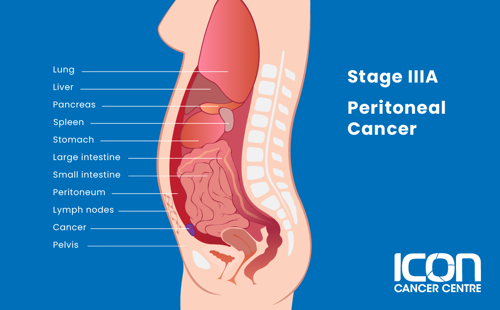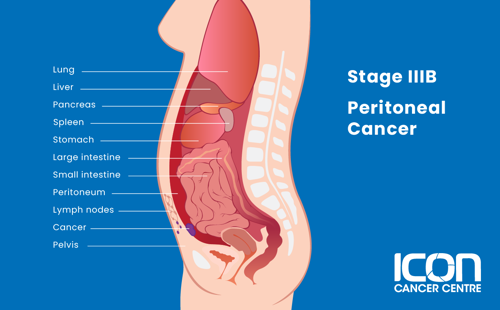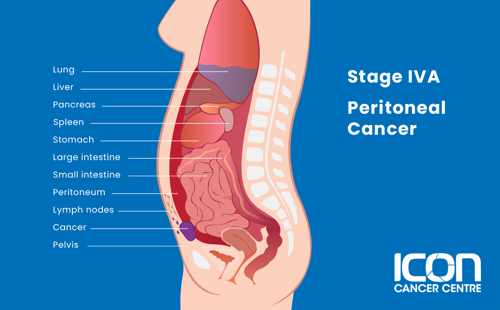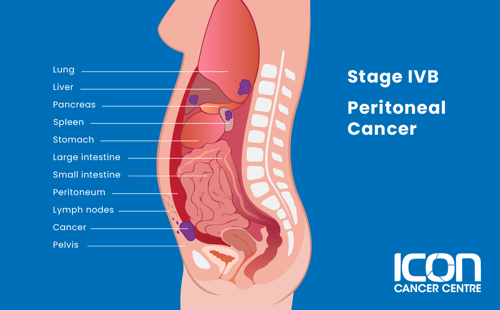Quick facts about peritoneal cancer
Primary peritoneal cancer is a rare cancer which develops in the cells of the peritoneum. This condition is more common in women than men, and most people are over the age of 60 when they are diagnosed
The peritoneum is made of epithelial cells, which is the same type of tissue that lines the ovaries
Peritoneal cancer often acts and looks like ovarian cancer, causing similar symptoms and typically requiring the same types of treatments
Peritoneal metastases occur when other abdominal cancers such as appendix, stomach, bowel and ovarian cancers spread to the peritoneum. Peritoneal metastases are more common than primary peritoneal cancer
Types of peritoneal cancer
The peritoneum is the tissue that lines and protects the organs in the abdomen such as the stomach, bowel and ovaries. Cancers affecting the peritoneum include:
-
Primary peritoneal cancer
This develops in the cells of the peritoneum (the tissue that lines and protects the organs in the abdomen such as the stomach, bowel and ovaries).
-
Peritoneal metastases
This refers to cancer that has spread to the peritoneum from other organs within the abdomen such as the appendix, bowel, stomach or ovaries. Peritoneal metastases are classified by their primary cancer. For example, ovarian cancer which has spread to the peritoneum is known as metastatic ovarian cancer.
Signs and symptoms of peritoneal cancer
As signs and symptoms for primary peritoneal cancer and peritoneal metastases can be similar to other common conditions, it’s important to see your GP or healthcare professional if you experience any of the symptoms below. Discussing anything concerning as soon as possible can help give you peace of mind and offer the best chance of successful treatment if you receive a peritoneal cancer diagnosis.
Symptoms may include:

Bloating or an extended abdomen

Reduced appetite or a feeling of being full after small meals

Pain in the abdomen or pelvic area

Changes in urinating, more frequent or urgent need to pass urine

Bleeding between periods or after menopause

Changes in bowel habits such as constipation or diarrhoea

Unexplained weight loss

Tiredness

Nausea and vomiting
Stages of peritoneal cancer
Primary peritoneal cancer is typically staged using the FIGO (International Federation of Gynaecology and Obstetrics) system, which helps define what your cancer looks like. Primary peritoneal cancer is often diagnosed at a more advanced stage – Stage III or Stage IV, because the symptoms in the early stages are often missed.
Peritoneal metastases, or cancers that have spread from other areas of the body to the peritoneum, are considered advanced cancers and are typically classified as Stage IV based on the staging of their primary cancer type.
The FIGO system, along with other tests, helps determine the stage of your primary peritoneal cancer using the guidelines below:
-
Stage IIIA
The cancer has spread to the lymph nodes outside of the peritoneum, or to the surface of the peritoneum outside of the pelvis.

-
Stage IIIB
The cancer has grown into the peritoneum outside the pelvis and the cancer in the peritoneum is 2 cm or smaller. The cancer may also have spread to lymph nodes outside the peritoneum.

-
Stage IIIC
The cancer has spread to the peritoneum outside the pelvis and the cancer in the peritoneum is larger than 2 cm. The cancer may also have spread to lymph nodes outside the peritoneum or to the surface of the liver or spleen.

-
Stage IVA
The cancer has caused a build-up of fluid in the lungs (pleural effusion).

-
Stage IVB
The cancer has spread to areas outside of the abdomen, such as the lungs or inside of the liver or spleen.

Treatment for peritoneal cancer
There are many different types of treatment for peritoneal cancer. Your treatment will depend on you and your cancer.




